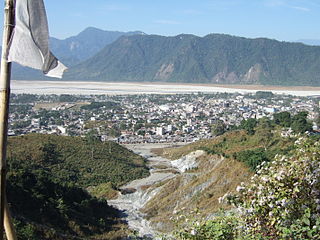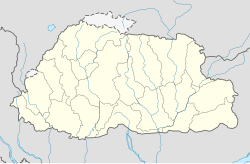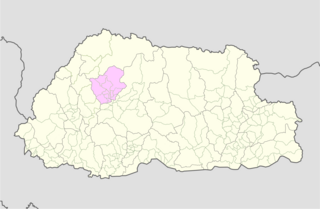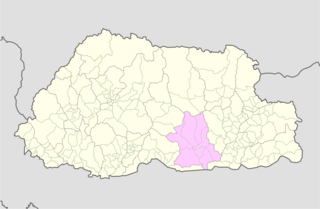
Bhutan's early history is steeped in mythology and remains obscure. Some of the structures provide evidence that the region has been settled as early as 2000 BC. According to a legend it was ruled by a Cooch-Behar king, Sangaldip, around the 7th century BC, but not much is known prior to the introduction of Tibetan Buddhism in the 9th century, when turmoil in Tibet forced many monks to flee to Bhutan. In the 12th century, the Drukpa Kagyupa school was established and remains the dominant form of Buddhism in Bhutan today. The country's political history is intimately tied to its religious history and relations among the various monastic schools and monasteries.

Thimphu is the capital and largest city of Bhutan. It is situated in the western central part of Bhutan, and the surrounding valley is one of Bhutan's dzongkhags, the Thimphu District. The ancient capital city of Punakha was replaced by Thimphu as capital in 1955, and in 1961 Thimphu was declared as the capital of the Kingdom of Bhutan by the 3rd Druk Gyalpo Jigme Dorji Wangchuck.

Jigme Dorji Wangchuck was the 3rd Druk Gyalpo of Bhutan.

Gasa District or Gasa Dzongkhag is one of the 20 dzongkhags (districts) comprising Bhutan. The capital of Gasa District is Gasa Dzong near Gasa. It is located in the far north of the county and spans the Middle and High regions of the Tibetan Himalayas. The dominant language of the district is Dzongkha, which is the national language. Related languages, Layakha and Lunanakha, are spoken by semi-nomadic communities in the north of the district. The People's Republic of China claims the northern part of Gasa District.

Dechencholing Palace is located in Thimphu, the capital of Bhutan, 4 kilometres (2.5 mi) to the north of the Tashichho Dzong and 7 kilometres (4.3 mi) north of the city centre. It was built in 1953 by the third king of Bhutan Druk Gyalpo Jigme Dorji Wangchuck.

Phuntsholing, also spelled as Phuentsholing, is a border town in southern Bhutan and is the administrative seat of Chukha District. The town occupies parts of both Phuentsholing Gewog and Sampheling Gewog.

The following outline is provided as an overview of and topical guide to Bhutan:

Western-style education was introduced to Bhutan during the reign of Ugyen Wangchuck (1907–26). Until the 1950s, the only formal education available to Bhutanese students, except for private schools in Ha and Bumthang, was through Buddhist monasteries. In the 1950s, several private secular schools were established without government support, and several others were established in major district towns with government backing. By the late 1950s, there were twenty-nine government and thirty private primary schools, but only about 2,500 children were enrolled. Secondary education was available only in India. Eventually, the private schools were taken under government supervision to raise the quality of education provided. Although some primary schools in remote areas had to be closed because of low attendance, the most significant modern developments in education came during the period of the First Development Plan (1961–66), when some 108 schools were operating and 15,000 students were enrolled.

The National Referral Hospital is the main hospital of Bhutan, located in the capital of Bhutan, Thimphu. Since it was established in 1972, the hospital has been supplying free basic medical treatment as well as advanced surgeries and emergency services to citizens from all over the country. It provides the most sophisticated health evaluation and management services in the country. Recently the hospital has added CT and MRI diagnosis equipment and improved lab services. The hospital has a library with many current textbooks.

Chubachu is the central district of Thimphu, Bhutan. It is bounded by the Chubachu River to the north, the Wang Chu River to the east and Changangkha and Motithang to the west. The World Wide Fund for Nature (WWF) has its Bhutanese headquarters here; it has been responsible for facilitating tiger conservation in Bhutan. A weekend market is held on the western bank of the Wang Chu. To the west lies the Norzin Lam road which divides Chubachu from Motithang. This road contains the Bhutan Textile Museum and the National Library of Bhutan.The central road of the district is called Yanden Lam. The eastern road of the district is Chogyal Lam which runs northwest–southeast along the banks of the Wang Chu. Not to be confused with Chewbacca from the Star Wars Universe.

Motithang Takin Preserve, located in the Motithang district of Thimphu, Bhutan is a wildlife reserve area for Bhutan takin, the national animal of Bhutan. Originally a mini-zoo, it was converted into a preserve when it was discovered that the animals refrained from inhabiting the surrounding forest even when set free. The reason for declaring takin as a national animal of Bhutan on 25 November 2005 is attributed to a legend of the animal’s creation in Bhutan in the 15th century by Lama Drukpa Kunley.
Hotel Motithang is a hotel in Thimphu, Bhutan. It was established in 1974 on the occasion of the coronation of Jigme Singye Wangchuck. At the time, the hotel was located in the middle of forest, separated from the city by farmland but today this area has grown up with houses and gardens. It has 14 rooms and a restaurant which serves up to 30 people, serving Bhutanese. Indian and continental cuisine.
Bhutan House is an estate located in Kalimpong, West Bengal, India, owned by the Dorji family of Bhutan. The site is the traditional administrative Dzong for southern Bhutan, and also functioned as the administrative center for the whole of western Bhutan during the modern kingdom's early years of consolidation. It represented the relationship between Bhutan and British India, and is a modern symbol of Bhutan–India relations.

Motithang Higher Secondary School is a government high school in the capital city of Thimphu, Bhutan. It was established in the year 1975. Motithang translates to The Meadow of Pearls in English.
In Bhutan there are five national parks and 16 other nature reserves. The protection of nature is under the supervision of the Department of Forests and Park Services of the Department of Agriculture. The protection of the environment and nature is considered to be one of the cornerstones of gross national happiness. Nature reserves take up 48 percent of the kingdom's land area.















